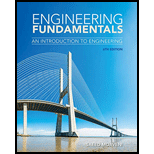
ENGINEERING FUNDAMENTALS
6th Edition
ISBN: 9781337705011
Author: MOAVENI
Publisher: CENGAGE L
expand_more
expand_more
format_list_bulleted
Question
Chapter 12.2, Problem 6BYG
To determine
Explain the ohm’s law.
Expert Solution & Answer
Want to see the full answer?
Check out a sample textbook solution
Students have asked these similar questions
An average operating data for conventional activated sludge treatment
plant is as follows:
(1) Wastewater flow, Q = 50000m³/d
A- Design grit removal chamber for a W.W.P with hourly flow equal 5000
m'h
B-Answer five of the following:
1-....... is the storm runoff that occurs from rainfall?
(15 mark)
(10 mark)
2- A protective device used to remove large and coarse
materials from the wastewater
3-....... utilize a relative porous bacteria growth medium such as rock
or formed plastic shapes
4- There are two basic methods of introducing air into the aeration
tanks are....... And .........
5-..... to water bodies such as rivers will be described by Streeter-
Phelp's equation
6- .... is the liquid conveyed by a sewer, it may consist of any one or
a mixture of liquid wastes.
(2) Volume of aeration tank, V-12000m
(3) Influent BOD, Y.- 300 mg/1
(4) Effluent BOD, Y, 25 mg/1
(5) Mixed liquor suspended solids (MLSS), X,-2500mg/1
(6) Effluent suspended solids, X-30mg/1
(7) Waste sludge suspended solids, XR-9700mg/1
(8) Quantity of waste sludge, Q., 220m³/d
100
Based on the information above data, determine:
(a) Aeration period (hrs.)
(b) Food to microorganism ratio (F/M) (kg BOD per day/kg MLSS)
(c) Percentage efficiency of BOD removal
(d) Sludge age (days)
Chapter 12 Solutions
ENGINEERING FUNDAMENTALS
Ch. 12.1 - In what unit is electric current measured?Ch. 12.1 - Prob. 2BYGCh. 12.1 - Prob. 3BYGCh. 12.1 - Prob. 4BYGCh. 12.1 - Prob. 5BYGCh. 12.1 - Prob. BYGVCh. 12.2 - Prob. 1BYGCh. 12.2 - Prob. 2BYGCh. 12.2 - Prob. 3BYGCh. 12.2 - Prob. 4BYG
Ch. 12.2 - Prob. 5BYGCh. 12.2 - Prob. 6BYGCh. 12.2 - Prob. BYGVCh. 12.5 - Prob. 1BYGCh. 12.5 - Prob. 2BYGCh. 12.5 - Prob. 3BYGCh. 12.5 - Prob. 4BYGCh. 12.5 - Prob. 5BYGCh. 12.5 - Prob. 6BYGCh. 12.5 - Prob. BYGVCh. 12 - Prob. 1PCh. 12 - Prob. 2PCh. 12 - Prob. 3PCh. 12 - Prob. 6PCh. 12 - Prob. 7PCh. 12 - Prob. 8PCh. 12 - Prob. 9PCh. 12 - Prob. 10PCh. 12 - Prob. 13PCh. 12 - Prob. 16PCh. 12 - Prob. 18PCh. 12 - Prob. 19PCh. 12 - Prob. 20PCh. 12 - Prob. 21PCh. 12 - Prob. 23PCh. 12 - Prob. 24PCh. 12 - As you know, a fuse is a safety device that is...Ch. 12 - Prob. 27PCh. 12 - Prob. 28PCh. 12 - Prob. 29PCh. 12 - Prob. 30PCh. 12 - Prob. 31PCh. 12 - Prob. 33PCh. 12 - Prob. 34PCh. 12 - Prob. 35PCh. 12 - Prob. 36PCh. 12 - Prob. 37P
Knowledge Booster
Similar questions
- Write handwritten solution, answer a,b and c Refer to the soil profile shown in the Figure a. Calculate the variation of o, u, and o' with depth. b. If the water table rises to the top of the ground surface, what is the change in the effective stress at the bottom of the clay layer? c. How many meters must the groundwater table rise to decrease the effective stress by 15 kN/m? at the bottom of the clay layer?arrow_forwardWater is discharged into the atmosphere through a bent nozzle of an angle (a) as shown in the figure. The cross-sectional area at the nozzle inlet and outlet are (Ain) and (Aout), respectively. The discharge through the nozzle is (Q). The gauge pressure at the nozzle inlet is (Pin). The bend lies in a horizontal plane. Vin Ain Aout Atmosphere Vout Problem (9): Given the values of Ain [m²], Aout [m²], Pin [atm], Q [m³/s], and a [degrees], calculate the magnitude of the reaction force component in x-direction (Rx) in [N]. Givens: A in = 0.301 m^2 Aout Pin = 0.177 m^2 1.338 atm Q α = 0.669 m^3/s 37.183 degrees Answers: ( 1 ) 23028.076 N ( 2 ) 29697.962 N ( 3 ) 18633.611 N ( 4 ) 14114.988 Narrow_forwardPlease answer the following question in the picture and show all of your work please.arrow_forward
- Please answer the following questions and make sure you answer each question please.arrow_forwardWater is discharged into the atmosphere through a bent nozzle of an angle (a) as shown in the figure. The cross-sectional area at the nozzle inlet and outlet are (Ain) and (Aout), respectively. The discharge through the nozzle is (Q). The gauge pressure at the nozzle inlet is (Pin). The bend lies in a horizontal plane. Ain Vin Aout X Atmosphere Vout Problem (10): Given the values of Ain [m2], Aout [m²], Pin [atm], Q [m³/s], and a [degrees], calculate the magnitude of the reaction force component in y-direction (Ry) in [N]. Givens: A in 0.169 m^2 A out Pin 0.143 m^2 0.552 atm = Q α 0.367 m^3/s = 31.72 degrees Answers: ( 1 ) 6264.193 N (2) 12041.886 N ( 3 ) 8715.747 N ( 4 ) 7139.937 Narrow_forwardProblem (12): A pump is being used to lift water from the bottom tank to the top tank in a pipe of diameter (d) at a discharge (Q). The pipe system comprises four Long radius 90° threaded elbows. The pipe entrance is sharp-edged, and the pipe exit is sudden. A Ball valve (1/3 closed) is used to control the discharge in the pipeline. Given the values of Q [Lit/s], and d [cm], calculate the power loss due to components (i.e., minor losses) in the pipe (Wminor-loss) in [W]. Givens: Q = 12.275 lit/s d = 6.266 cm Answers: ( 1 ) 1142.006 W (2) 952.086 W ( 3 ) 1225.555 W ( 4 ) 1331.216 W Loss Coefficients for Pipe Components (h,= K,Y) Component a. Elbows KL elbow Regular 90°, flanged 0.3 Regular 90°, threaded 1.5 Long radius 90°, flanged 0.2 V 90° elbow Long radius 90°, threaded 0.7 Long radius 45°, flanged 0.2 0.4 Regular 45°, threaded . 180° return bends 180° return bend, flanged 0.2 V 45° elbow 180° return bend, threaded 1.5 c. Tees Line flow, flanged 0.2 Line flow, threaded 0.9 180°…arrow_forward
- Compute for the stresses (initial, const and final stage) and check for compliance in NSCP provisions. Also compute the following: 1. Compute and check if the section is Uncracked, Transition or Cracked as per NSCP. 2. Compute for its flexural capacity and check if it could carry the given load. BEAM SECTION NOT TO SCALE 1400mm 300 $1098 400 */ 400*300* 300 200 300 100 ORIGINAL SECTION/PRECA CAST-IN-PLACE (CIP) PART PRECAST LOADING AT SERVICE M • 21 KN (DEAD LOAD ONLY) 21KN 4.75m 9.25m CIVEN DATA STRANDS: 12-02 AT 120KN/STRAND (GOMM FROM BOTTOM) 8-2 AT 120HN/STRAND (120mm FROM BOTTOM) fc 42.5 MPa (BEAM) fc 38 MPa (CIP) f'a = 80% or fa fp-1860 MPa ESTRANDS 1976Pa OONG 23.6/m³ LOES 1-8% Loss 18% APPLY 3M LIVE LOAD AT CONST. PHASEarrow_forward4. Determine the stability of the cantilever shown in the figure below (use Coulomb earth theory for the lateral stress due to the backfill material). 1 m 0.5 m Backfill 7 = 18.5 kN/m³ • = 30° 20 6 = 20° 6 m Y₁ = 24 kN/m³ 1.2 m 1 m 4.5 m Base soil Clay: 7 = 19 kN/m³,0 = 30%, 0,, = 20°, s,, = 94 kPa a. With s₁ = c = 94 kPa (disregard values), determine allowable soil bearing capacity of the base soil if the factor of safety is equal to 3. b. Determine the FS against overturning. C. Determine the FS against sliding if the coefficient of friction between footing concrete base and soil is b. d. Determine the FS for bearing capacity.arrow_forwardDirections: Show your solutions explicitly, i.e., do not just write the final answer. 1. A wall footing is to be constructed on a clay soil 1.4 below the ground. The footing is to support a wall that imposes a load of 130 kN per meter of wall length. Considering general shear failure, determine the following: 130 kN/mm 1.4 m a. Footing width if the factor of safety is 3. b. Ultimate bearing capacity if B = 0.95 m. C. New factor of safety. y = 17.92 kN/m² c = 14.5 kPa $ = 30° 1.5 m and has its hottom 2 m below the ground surface.arrow_forward
- 2. A square footing shown has a dimension of 1.5 m x 1.5 m and has its bottom 2 m below the ground surface. The groundwater table is located at a depth of 3 m below the ground surface. Assume a general shear failure. Determine the following: 2 m y = 16 kN/m³ c = 14.5 kPa → = 28° 3 m 1,5 m ysat 18.5 kN/m³ a. Ultimate bearing capacity of the soil beneath the footing (in kPa). b. Allowable bearing capacity if it has a factor of safety of 3 (in kPa). C. Allowable load that the footing could carry (in kN). d. Allowable net bearing capacity if factor of safety is 3. Allowable net load if factor of safety is 3.arrow_forwardProblem (11): A pipe discharges an unknown fluid into the atmosphere from a tank of depth (h) through a pipe of length (L), and diameter (d). Given the values of L [m], d [cm], and (h) [cm], calculate the discharge rate (Q) [lit/s] that would maintain Laminar flow in the pipe with a Reynolds number of Re-1500. Ignore minor losses. Givens: L = 139.364 m d = 12.614 cm h = 76.609 cm Answers: ( 1 ) 6.911 lit/s (2) 8.179 lit/s ( 3 ) 4.244 lit/s (4) 4.987 lit/s h darrow_forwardB2. For the truss below, determine all member forces. Hint: see the provided slide with the problem set. P₁ = 12 kip and P2 = 6 kip (20 pts). P₁ A 16 ft D 8 ft 8 ft 8 ft B J K E 8 ft 8 ft I H G 8 ft 8 ft 8 ft B₁₂ F ΠΟΙΟΣarrow_forward
arrow_back_ios
SEE MORE QUESTIONS
arrow_forward_ios
Recommended textbooks for you
 Engineering Fundamentals: An Introduction to Engi...Civil EngineeringISBN:9781305084766Author:Saeed MoaveniPublisher:Cengage Learning
Engineering Fundamentals: An Introduction to Engi...Civil EngineeringISBN:9781305084766Author:Saeed MoaveniPublisher:Cengage Learning Materials Science And Engineering PropertiesCivil EngineeringISBN:9781111988609Author:Charles GilmorePublisher:Cengage Learning
Materials Science And Engineering PropertiesCivil EngineeringISBN:9781111988609Author:Charles GilmorePublisher:Cengage Learning Solid Waste EngineeringCivil EngineeringISBN:9781305635203Author:Worrell, William A.Publisher:Cengage Learning,
Solid Waste EngineeringCivil EngineeringISBN:9781305635203Author:Worrell, William A.Publisher:Cengage Learning, Architectural Drafting and Design (MindTap Course...Civil EngineeringISBN:9781285165738Author:Alan Jefferis, David A. Madsen, David P. MadsenPublisher:Cengage Learning
Architectural Drafting and Design (MindTap Course...Civil EngineeringISBN:9781285165738Author:Alan Jefferis, David A. Madsen, David P. MadsenPublisher:Cengage Learning Construction Materials, Methods and Techniques (M...Civil EngineeringISBN:9781305086272Author:William P. Spence, Eva KultermannPublisher:Cengage Learning
Construction Materials, Methods and Techniques (M...Civil EngineeringISBN:9781305086272Author:William P. Spence, Eva KultermannPublisher:Cengage Learning Residential Construction Academy: House Wiring (M...Civil EngineeringISBN:9781285852225Author:Gregory W FletcherPublisher:Cengage Learning
Residential Construction Academy: House Wiring (M...Civil EngineeringISBN:9781285852225Author:Gregory W FletcherPublisher:Cengage Learning

Engineering Fundamentals: An Introduction to Engi...
Civil Engineering
ISBN:9781305084766
Author:Saeed Moaveni
Publisher:Cengage Learning

Materials Science And Engineering Properties
Civil Engineering
ISBN:9781111988609
Author:Charles Gilmore
Publisher:Cengage Learning

Solid Waste Engineering
Civil Engineering
ISBN:9781305635203
Author:Worrell, William A.
Publisher:Cengage Learning,

Architectural Drafting and Design (MindTap Course...
Civil Engineering
ISBN:9781285165738
Author:Alan Jefferis, David A. Madsen, David P. Madsen
Publisher:Cengage Learning

Construction Materials, Methods and Techniques (M...
Civil Engineering
ISBN:9781305086272
Author:William P. Spence, Eva Kultermann
Publisher:Cengage Learning

Residential Construction Academy: House Wiring (M...
Civil Engineering
ISBN:9781285852225
Author:Gregory W Fletcher
Publisher:Cengage Learning